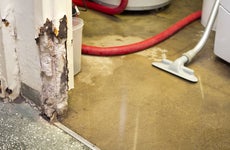Recoverable depreciation in home insurance: what it is and how it works

The Bankrate promise
At Bankrate, we strive to help you make smarter financial decisions. To help readers understand how insurance affects their finances, we have licensed insurance professionals on staff who have spent a combined 47 years in the auto, home and life insurance industries. While we adhere to strict , this post may contain references to products from our partners. Here's an explanation of . Our content is backed by Coverage.com, LLC, a licensed entity (NPN: 19966249). For more information, please see our .
When looking to purchase home insurance or file a claim, you may encounter the terms replacement cost value (RCV) or actual cash value (ACV). If you have replacement cost coverage on your home insurance policy, you’re covered for the actual replacement cost of your home or personal property following a covered claim, depending on your coverage type and policy limits. However, you may not get the full replacement cost in your first claim check. If you get a lower amount, it’s likely that recoverable depreciation has been taken out of your payment. Below, Bankrate explains the nuances of RCV, ACV and recoverable depreciation in home insurance.
What is recoverable depreciation?
In insurance, depreciation refers to the loss of value in an item over time. Generally, you will hear the term recoverable depreciation if you have a home insurance policy with replacement cost value coverage. This is in contrast to an actual cash value policy, by which you are only covered for the depreciated value of your home or belongings. With an ACV policy, depreciation is not recoverable; you will only get the depreciated value of your home or property after a claim. However, if you have RCV coverage, you may be able to recoup the value by which any destroyed or damaged items have depreciated in the years since you purchased them. This amount is called recoverable depreciation.
In most cases, insurance depreciation is based on:
- The age of the item
- How well it has held up over the years
- How obsolete it is based on newer versions
Consider a television as an example. Imagine you purchased the TV five years ago for $500. In that time, the TV has depreciated — lost value — and is now worth maybe $100 due to its age and use. The TV is destroyed by fire in the home, a covered peril. However, due to inflation, the cost to replace the TV with a similar new model at today’s price is $700.
If you have an ACV policy, you would only get up to a $300 payout — today’s replacement cost minus the depreciated value of the TV — after it is damaged and destroyed (not factoring in that you would also have to pay your home insurance deductible). If you have an RCV policy, on the other hand, you may be able to get up to $700 so that you can buy a new comparable version at today’s market value. If the cost to purchase a new TV of comparable value today is $700, you may get a payout that is up to that amount.
You may still only get $300 as an initial claims check, but you could recover the additional $400 — the gap between the ACV and RCV — by purchasing a new TV and showing your insurer paid receipt for the replacement TV. The $400 is the recoverable depreciation.
What is nonrecoverable depreciation?
If you have an ACV policy, you will most likely not receive enough money in your insurance claim settlement to purchase items of the same quality as those you lost. You will either need to purchase cheaper items or use your own money on top of the settlement to purchase items of similar quality.
It may be helpful to read your policy documents carefully, even if you have an RCV policy. There can be many variations in what home insurance covers, and it’s important to know what your policy does and doesn’t include. For example, standard HO-3 policies typically include RCV for dwelling coverage but ACV for personal property coverage. You’ll likely need to pay extra for RCV coverage for your personal belongings.
How to calculate recoverable depreciation
Depreciation largely hinges on an item’s value, and value can be subjective. As a result, you might be wondering how insurance providers arrive at the total recoverable depreciation amount for any given claim. In most cases, they turn to an item’s useful life.
Say you buy a refrigerator in 2016 for $1,500, and the fridge’s useful life is estimated to be 14 years. By dividing its lifespan (14 years) by the total cost ($1,500), home insurance companies can arrive at a data-based insurance recoverable depreciation estimate. In this example, for each year of the fridge’s life, it would depreciate by roughly $107. This calculation may vary by provider, circumstances and item type, as well as your specific policy details.
Learn more: Does your homeowners insurance go up after a claim?
How recoverable depreciation affects a home insurance claim
With both ACV and RCV coverage types, the first part of the home insurance claim process is the same: a covered peril damages or destroys your property’s structure or your personal belongings (or both). From there, you might call your agent or file your claim online, and a claims adjuster assesses the depreciated value of the item or property.
If your personal property coverage pays out on an ACV basis, once the adjuster’s assessment has been accepted by the company, you will receive a check for the replacement cost minus the depreciated value. If you have valuable personal property that depreciates rapidly, such as many computers, you may face out-of-pocket costs to replace them after a loss.
If your personal property coverage pays out on an RCV basis, recoverable depreciation will likely be calculated for all destroyed items after a covered loss — as it was with ACV policy items. However, there will be further action to determine what the current market value is for a similar new version of each item.
As a quick recap, here are the steps you might expect with RCV coverage:
- The covered loss occurs: Following a covered peril that causes damage, the first step (typically after emergency services have become involved) is to call your insurance agent and start your claim process.
- Your insurance provider calculates ACV: A claims adjuster will usually visit the premises and assess damages and the ACV of the compromised belongings, even if you have an RCV policy. You will then receive a claims check for the ACV of any destroyed or stolen items, minus the amount of your deductible.
- You replace the items or repair the damage: Using the ACV check you received, you’ll purchase new items of similar make and quality or repair the damage to your home, even if your check doesn’t cover the full cost. To recover the depreciation, you will then usually need to prove you have replaced the item or fixed the damage to your house within a certain timeframe and with specific documents (e.g., sales receipts). Confirm with your agent or claim representative what is required under your policy.
- Your insurance provider pays out the recoverable depreciation: Once you have proven that you replaced the destroyed or stolen items (or repaired the damage to your home) with new items and show your insurance provider how much you paid for them, you are then typically issued a second check for the recoverable depreciation amount.
How do I get my recoverable depreciation back?
Most insurance providers have very specific steps about how to claim the recoverable depreciation check. If a deadline applies, be sure to submit any required documentation in time.
One important thing to note here: if you find a great deal on an item on sale, you should not expect to pocket the savings.
Circling back to our refrigerator example: say you find a comparable replacement model on sale for $1,200 rather than the original price of $1,500. When you submit the receipt to your insurer, they will likely pay you enough to cover the $1,200 purchase amount, not the full $1,500 original value of the fridge. Remember, too, that you’ll have to pay your deductible if you file a claim for home or personal property damage.
Expanding on the fridge example further, here’s how the numbers could play out:
| Incident | Amount |
|---|---|
| Fridge value at the time of purchase in 2018 (i.e., its replacement cost) | $1,500 |
| Useful life | 14 years |
| Depreciation per year | $107 ($1,500 ÷ 14) |
| The fridge gets destroyed in a covered loss in 2023 | |
| Total recoverable depreciation | $535 ($107 x five years of use) |
| Actual cash value at the time of the covered loss | $965 ($1,500 – $535) |
| Policy deductible | $500 |
| First claim check amount | $465 ($965 ACV – $500 deductible) |
| New fridge purchase cost | $1,500 |
| Second claim check (recoverable depreciation) amount | $535 |
| Total claim amount | $1,000 (fridge total, minus $500 deductible) |
Why do insurance companies use recoverable depreciation?
Why do insurers make you go through all of these extra steps rather than cutting you a single check minus your deductible? It would seem at first that this would make it easier for both the insurer and the policyholder. There are a couple of reasons why insurers use recoverable depreciation:
- It helps prevent insurance fraud. For example, you would not be able to pocket the $1,000 check (which would be the full amount you’d get for a $1,500 fridge minus the $500 deductible) for the damaged or destroyed fridge while at the same time getting a free one from your in-laws who happened to be getting rid of theirs.
- It helps insurers avoid paying more than is necessary. If you found your new replacement fridge for a lesser amount, your second claim check will only bring your total claim amount up to the cost of that amount (minus your deductible). Balancing costs like this helps insurers keep their claims reserves — the amount of money set aside to pay losses — at a healthy level.
- It ensures you do actually replace the items that were destroyed. For example, if you decided you no longer need a fridge, you would just receive the value of the depreciated item and not the second amount because you did not actually replace it.
Ultimately, recoverable depreciation requires some extra steps but may be worth it for items that lose value quickly over time. To get your second claim check, you will likely need to submit sales receipts proving the amount you paid for your replacement items. You may want to review your policy and your insurance provider’s processes for recoverable depreciation so you can be ready after a covered loss.
Frequently asked questions
-
-
Depending on your home insurance policy, your dwelling and personal property coverage may already include RCV for one or both coverage types. However, if it doesn’t, you may be trying to decide if ACV or RCV is right for you. The best way to do this is likely to evaluate your belongings and their value. If the cost to replace items out of pocket after a covered loss would be a financial strain for you, the extra premium cost of RCV may be worth it for you. Speaking with a licensed insurance agent may help you decide if paying for RCV coverage is the right call.
-
Once repairs are made, or items are replaced, the homeowner typically receives the recoverable depreciation check, not the contractor or company making repairs. However, the process may vary based on the terms of the policy and the nature of your claim. Check with your insurer or agent to better understand how it handles these situations.
-
Recoverable depreciation and replacement cost are related but are not the same thing. Replacement cost is the total cost to replace a structure or item with a new version of comparable quality. On the other hand, recoverable depreciation is the difference between the cost to replace something and its actual cash value. Home insurers often offer both options when customers are purchasing a policy. While replacement cost policies have the obvious advantage of potentially paying more toward replacing items, actual cost policies tend to involve lower premiums.
-
How long you have to notify your insurer and complete the process can vary between states, companies and policies. Some states mandate specific limits, while others do not. That time window generally ranges from six months to two years, with the lower end of that range being more common. It’s essential to check with your insurer and policy to make sure you file your claims within the allowable time limits. If you wait until that window has expired, you may end up paying out of pocket more than you otherwise would.
-
Related Articles



